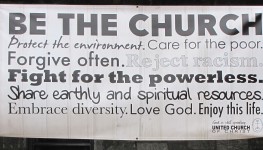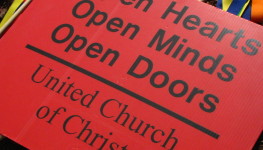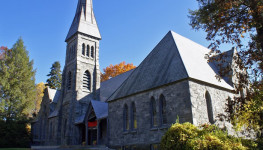“Cloud of Witnesses”
Hebrews 12:1-2
John 11:32-44
Sometimes the great cloud of witnesses is something that lives in our hearts. Sometimes it’s that place in our brains and our hearts where the best memories of our loved ones live. Sometimes we are able to trust that there really is a realm where all who have gone before live on, and from that place of never-fading glory they cheer us on. And sometimes the great cloud of witnesses is little more than some words in the Bible that we may or may not understand.
But sometimes—sometimes that great cloud of witnesses is as personal as the names forever inscribed on our hearts and as real as the photographs of loved ones you have so tenderly put on this table. Sometimes the great cloud of witnesses is just a poetic way of thinking about our ancestors and others who have gone before us, and sometimes it is as real and close as the soil from the cemetery that sticks to our shoes.
I don’t know what happens when people die—though I’ve accompanied enough people through the process to believe there is something—and, more important, someone—on the other side of the veil. I’ve heard enough deathbed visions to think that while death takes our beloveds from us, it may reunite them with dear ones who’ve gone on before.
My people are buried in a simple, cooperatively-owned cemetery in the piney woods of East Texas. Stately live oaks tower over the graves, Spanish moss hanging from their branches like so many ladders connecting earth to heaven. Once a year the cemetery hosts a homecoming, and the living gather ’round their dead for an afternoon of visiting and pecan pie.
When the time came to lay my grandmother Edra to rest in the red clay soil of that place, the local preacher—her nephew and my dad’s double-first cousin—did the honors. Looking around, he reminded us that she was in good company.
The remains of her husband, Morris, rested on one side of her; her second-born child, Aubrey, whose death at 18 months old broke her heart, was on the other. Over there lay her identical twin, Neva. Over yonder were her sisters Iva, Roda, and Opal, her brothers Travis and Verdon, and her grandson Keith.
She had, in other words, joined the great cloud of dear ones and witnesses, even as her body was lowered down into a grave surrounded by her still-living children, grandchildren, and grandchildren, nieces, nephews, and longtime friends.
In the Letter to the Hebrews the great cloud of witnesses is all about remembering the faithful and courageous ones who’ve gone before us. It’s a way of finding strength and hope in remembering their witness. It is about letting their ongoing living presence encourage and empower us to keep going in this earthly life and on our spiritual journeys, knowing that we do not run this race alone, but rather are carried by the love of God and the spirits of the saints.
That’s also at least part of the idea behind All Saints Day, and why we celebrate it here at First Church as a bit of a mash-up of All Saints and All Souls (occasionally with a little Halloween, or All Hallows’ Eve, thrown in).
It’s not only about remembering and honoring the loved ones we have lost, as important as that is. It’s also about recognizing our place in the big picture of God’s mercy and grace: how the way was paved for us by those who came before—not only the official saints, but also the parents and teachers and friends, mentors and church members, writers and even strangers who were and are instruments of God’s love in our lives. It’s about understanding that we, too, are saints—called to be instruments of God’s love and grace to the people in our lives and to all God’s beloved children and creation.
And, particularly in the the context of Celtic spirituality, All Saints is a time to recognize the spiritual connections between heaven and earth and how thin the veil is that separates the living from the dead.
As Christopher Grundy writes and sings, and as we soon will hear: “Heaven and earth are filled with the light of the saints who have gone on before us, shining around us still as we’re running this race, grateful our path is lit for us.”
As beautiful as all that is, we cannot have the shining saints and the lighted path without the shadows of separation. Which is to say: We cannot have life on earth without death. Which is to say: We cannot know love without also, some day, knowing grief.
There is much to say about the Lazarus story, not least of which is the sense that life with God, life in the kingdom or realm of God, is very much about life itself. How the ancient prophets and Jesus himself were forever imploring the people to choose life, how the people were forever dying in one way or another, and how the basic promise of God so often boiled down to opening graves and bringing people out of them into new and abundant life.
But first, and always, there is death. And where there is loss and death, there is grief.
One of the things I appreciate most about the Lazarus story is that it shows Jesus grieving—openly, deeply, and without shame, embarrassment, or guilt. Jesus, who knows better than anyone that what looks like the end is not really the end, sees and understands the pain that loss brings. Jesus, who is the only one who knows what he is about to do, enters into the pain of Lazarus’s sisters and the pain of the entire community. He does not dismiss it or try to avoid it; instead he acknowledges it, shares it, and then addresses it.
In a display of deep love, Jesus reveals that death and grief do not have the last word. And we don’t have to be miracle workers to get beyond grief; we don’t overcome death and loss by denying their painful reality.
"If we allow grief to do its work,” says Jan Richardson, “the love that lives within it becomes ever more clear and present to us. In time, the love has a way of overtaking the grief, so that our loving, rather than our grieving, becomes our primary bond to what we have lost. It is, finally, this love that holds our cure. It is this love that is the cure. In the deepest pain that rends us, in the keenest solace that visits us, in the hope that does not release its hold on us, love lives, bearing itself toward us as sorrow’s most lasting cure.”
Jesus, in a display of love and power and liberation that will stun the crowds and reveal his identity as the Resurrection and the Life, calls Lazarus out of the tomb. And in a display of resistance and community-building that will convince the authorities that Jesus must be executed before things get totally out of hand, Jesus calls the people to unbind Lazarus and set him free from the power of death.
And this is what all saints, including those of us still living on earth, are meant to do: To liberate the prisoners, to bring to new life those who have all but died, and to usher the marginalized into the fullness of life and community.
On this All Saints Sunday, we need not have lost a loved one recently—though some us have—to be heart-deep in grief. Many more of us are grieving the ending of significant relationships, missing the way things used to be, mourning the loss of certainty, bemoaning what feels like the end of civility, or feeling shaken by the violation of trust and the persistence of division.
In all these ways we are not so different from the original hearers and readers of the Letter to the Hebrews who, having encountered persecution and suffering on the way with Jesus, were beginning to wonder whether to give up on faith in God and their hope in Jesus for a new world.
The writer’s message is plain: Remember those who have gone before you, those you have kept faith and hope alive and paved the way for you. Know that you are not alone in the struggle but that you are surrounded by a whole cloud-full of witnesses who are cheering your every step. Therefore, keep following Jesus and keep your eyes on the prize, which is justice and peace, life abundant, and joy in God.
Grieve fully, but don’t get lost in all that you’ve lost. Come out from your tomb, unbind your heart, and lift up your eyes to see how the light of the saints who have gone on before us is shining around us still. And be grateful that our path is lit for us.




